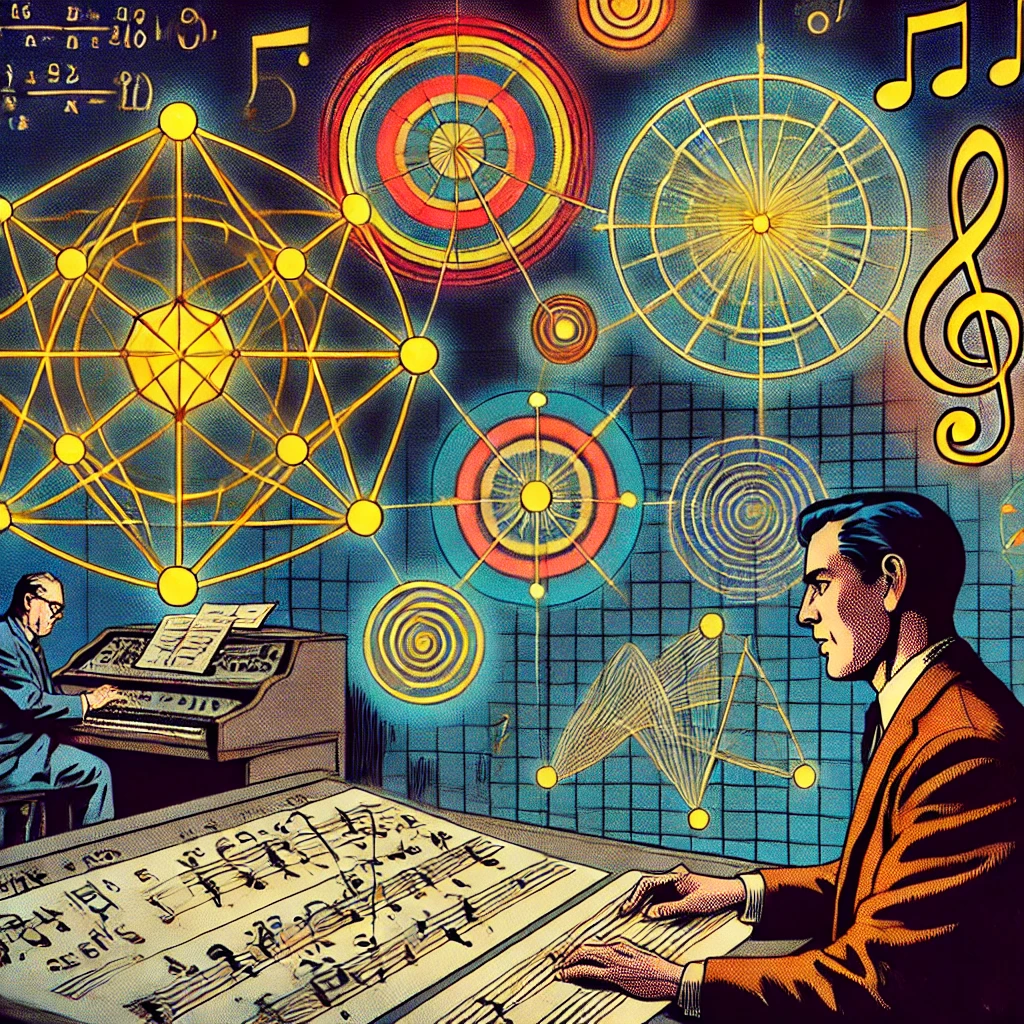Geometry of Consonance Music and Mathematics
…provides an accessible, multimedia introduction to this new way of thinking about music, in which the audience can both listen to and watch pieces of music as they move along cones, Mobius strips, and other geometric objects.
Elementary concepts of music theory can be translated into the language of contemporary geometry. Musical chords live in interesting geometrical spaces called “orbifolds” spaces.
The relationship between music and mathematics has been a subject of fascination for centuries, with various mathematical principles underlying the organization of musical sounds. One aspect of this relationship is the geometry of consonance, which explores the mathematical patterns and relationships underlying harmonious musical intervals.
Consonance refers to the perception of stability, harmony, and pleasantness in musical intervals and chords, whereas dissonance refers to the perception of tension, instability, and unpleasantness. The geometry of consonance seeks to understand the mathematical basis for these perceptions and the structural relationships between different musical intervals.
One fundamental concept in the geometry of consonance is the harmonic series, also known as the overtone series. The harmonic series is a sequence of frequencies that are integer multiples of a fundamental frequency. When a musical instrument produces a sound, it typically contains a fundamental frequency and a series of overtones that are integer multiples of the fundamental frequency. The relative amplitudes and frequencies of these overtones contribute to the timbre or quality of the sound.
In Western music theory, consonant intervals are often associated with simple frequency ratios that arise naturally in the harmonic series. For example:
1. The octave, which has a frequency ratio of 2:1, is considered the most consonant interval besides the unison. It represents a doubling or halving of the frequency and produces a perceptually similar tone.
2. The perfect fifth, with a frequency ratio of 3:2, is also considered highly consonant and stable. It is found in many musical traditions worldwide and is often used to establish tonal centers and harmonies.
3. The perfect fourth, with a frequency ratio of 4:3, is another consonant interval that is commonly used in Western music.
The geometry of consonance also involves mathematical concepts such as Pythagorean tuning, just intonation, and equal temperament, which explore different approaches to tuning musical intervals based on mathematical principles.
Overall, the geometry of consonance provides insight into the mathematical patterns and relationships that underlie the organization of harmonious musical sounds. By understanding these principles, composers, musicians, and theorists can create and analyze music with greater depth and appreciation for its underlying mathematical structure.
The “Geometry of Consonance” is a fascinating concept that lies at the intersection of music and mathematics, exploring how the principles of geometry can help explain the harmonic relationships and perceptions of consonance and dissonance in music. This approach provides a visual and mathematical framework for understanding how different musical intervals, chords, and scales relate to one another and how these relationships contribute to the overall sensation of harmony or tension in music.
Consonance and Dissonance: A Mathematical Perspective
Consonance and dissonance are fundamental to music theory, describing the quality of intervals or chords that sound harmonious or tense, respectively. Mathematically, these concepts can be traced back to the ratios of the frequencies involved in producing musical notes. Simple ratios (such as 2:1 for the octave, 3:2 for the perfect fifth, and 4:3 for the perfect fourth) are generally perceived as consonant, while more complex ratios tend to be perceived as dissonant.
The Role of Geometry
Geometry enters this domain by providing a way to visualize these relationships. One of the most well-known geometric representations of musical consonance is the Tonnetz (tone network), which arranges notes in a two-dimensional lattice that highlights the geometric relationship between intervals. In the Tonnetz, consonant intervals are represented by shorter distances, and harmonic progressions can be visualized as paths through the lattice.
Euler’s Tonnetz
Leonhard Euler, a pioneering mathematician of the 18th century, made significant contributions to the field by introducing the concept of the Tonnetz. He proposed a way of arranging notes that would visually demonstrate the relationships between them, based on their consonance and dissonance. This early work laid the groundwork for understanding music through a geometric lens, illustrating how spatial representations can mirror musical harmony.
Applications and Insights
The geometric approach to understanding music offers several insights:
– Harmonic Spaces: It allows for the conceptualization of harmonic spaces where chords and scales occupy specific regions, making theoretical concepts like modulation, voice leading, and chord substitution more visually intuitive.
– Music Analysis: Geometry provides tools for analyzing the structure of compositions, revealing underlying patterns and symmetries that might not be immediately apparent through traditional music theory alone.
– Composition and Exploration: Composers and musicians can use geometric models as creative tools to explore new harmonic possibilities, experiment with microtonal music, or develop unconventional tuning systems.
Recent Developments
Modern research in music theory and mathematics continues to expand on these ideas, employing advanced geometry, topology, and group theory to delve deeper into the structure of music. This includes exploring higher-dimensional spaces for understanding more complex chords and scales, as well as applying geometric models to rhythm and meter.
Conclusion
The “Geometry of Consonance” provides a compelling example of how music and mathematics intersect, offering a rich framework for exploring the intricacies of musical harmony. By visualizing musical relationships geometrically, theorists, composers, and musicians gain a deeper understanding of the principles that underlie musical consonance and dissonance, opening up new avenues for analysis, composition, and appreciation of music. This interdisciplinary approach not only enriches our understanding of music but also highlights the universal nature of mathematical principles as they manifest in the arts.
